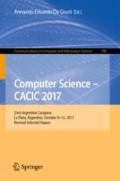Abstract
Developing Software Product Lines (SPLs) is a paradigm oriented to reusing software within particular domains. Key aspects within this paradigm are the inherent particularities of these domains and the techniques applied to systematize the ways to maximize reuse. In this article, we describe a process for creating SPLs by reusing through domain hierarchies, starting from the geographical domain and going deeper into the paleontological sub-domain. In particular, our process is based on standardizations and previous techniques already applied to another geographical sub-domain, which is marine ecology. Here we show how these techniques are applied in the paleontological sub-domain, improving the systematic reuse of software artifacts.
Access this chapter
Tax calculation will be finalised at checkout
Purchases are for personal use only
Notes
- 1.
The OpenGIS Abstract Specification: Service Architecture, 2002.
- 2.
Geographic information. Services International Standard 19119, ISO/IEC, 2005.
- 3.
Information and documentation – A reference ontology for the interchange of cultural heritage information.
- 4.
LIDO – Lightweight Information Describing Objects Version 1.0 – http://network.icom.museum/cidoc/working-groups/lido/what-is-lido/.
- 5.
CIDOC Conceptual Reference Model Version 6.0 – http://www.ccc-crm.org.
References
Buccella, A., Pol’la, M., Cechich, A., Arias, M.: A variability representation approach based on domain service taxonomies and their dependencies. In: International Conference of the Chilean Computer Science Society (SCCC), Talca (2014)
Arias, M., Buccella, A., Cechich, A.: Smooth transition from abstract to concrete SPL components: a client-server implementation for the geographic domain. In: Proceedings of the IEEE ARGENCON 2016. GRSS: IEEE GRSS, Buenos Aires (2016)
Arias, M., Buccella, A., Cechich, A.: Un marco de trabajo para la gestión de requerimientos de software en líneas de productos de software. In: XLIII Conferencia Latinoamericana en Informática. SLISW - Simposio Latinoamericano de Ingeniería de Software, CLEI 2017 (2017, to appear)
Bashroush, R., Garba, M., Rabiser, R., Groher, I., Botterweck, G.: Case tool support for variability management in software product lines. ACM Comput. Surv. 50(1), 14:1–14:45 (2017). http://doi.acm.org/10.1145/3034827
Benavides, D., Segura, S., Ruiz-Cortés, A.: Automated analysis of feature models 20 years later: a literature review. Inf. Syst. 35, 615–636 (2010)
Bosch, J.: Design and Use of Software Architectures: Adopting and Evolving a Product-Line Approach. ACM Press/Addison-Wesley Publishing Co., New York (2000)
Bosch, J.: From software product lines to software ecosystems. In: Proceedings of the 13th International Software Product Line Conference, SPLC 2009, pp. 111–119. Carnegie Mellon University, Pittsburgh (2009)
Braun, G., Pol’La, M., Cecchi, L., Buccella, A., Fillottrani, P., Cechich, A.: A DL semantics for reasoning over OVM-based variability models. In: 30th International Workshop on Description Logics (DL 2017), France (2017, to appear)
Buccella, A., Cechich, A., Arias, M., Pol’la, M., Doldan, S., Morsan, E.: Towards systematic software reuse of GIS: Insights from a case study. Comput. Geosci. 54, 9–20 (2013). http://www.sciencedirect.com/science/article/pii/S0098300412003913
Buccella, A., Cechich, A., Pol’la, M., Arias, M., Doldan, S., Morsan, E.: Marine ecology service reuse through taxonomy-oriented SPL development. Comput. Geosci. 73, 108–121 (2014). http://www.sciencedirect.com/science/article/pii/S0098300414002155
Burrough, P., McDonnell, R.: Principles of Geographical Information Systems. Oxford University Press, Oxford (1998)
Capilla, R., Sánchez, A., Dueñas, J.C.: An analysis of variability modeling and management tools for product line development. In: Proceedings of the Software and Services Variability Management Workshop: Concepts, Techniques, and Tools, pp. 32–47 (2007)
Clements, P.C., Northrop, L.: Software Product Lines: Practices and Patterns. Addison-Wesley Longman Publishing Co., Inc., Boston (2001)
Mancuso, M., Buccella, A., Cechich, A., Arias, M., Pol’la, M.: Datasheet modeler: Una herramienta de soporte para el desarrollo de funcionalidades en líneas de productos de software. In: Proceedings of the XXI Argentine Congress of Computer Science, CACIC 2015, Junin (2015)
Manikas, K., Hansen, K.M.: Software ecosystems - a systematic literature review. J. Syst. Softw. 86(5), 1294–1306 (2013)
Munir, Q., Shahid, M.: Software product line: survey of tools. Master’s thesis, Linkopings University, Linkopings (2010)
Parent, C., Spaccapietra, S., Zimányi, E.: Spatio-temporal conceptual models: data structures + space + time. In: Proceedings of the 7th ACM International Symposium on Advances in Geographic Information Systems, GIS 1999, pp. 26–33. ACM Press, New York (1999)
Pohl, K., Böckle, G., van der Linden, F.J.: Software Product Line Engineering: Foundations, Principles and Techniques. Springer, Heidelberg (2005). https://doi.org/10.1007/3-540-28901-1
Pol’la, M., Arias, M., Buccella, A., Cechich, A.: Un sistema de anotaciones para la especificación de componentes de una línea de productos de software. Revista Tecnología y Ciencia de la Universidad Tecnológica Nacional 6(1), 116–122 (2015)
Pol’la, M., Buccella, A., Arias, A., Cechich, A.: Sevatax: service taxonomy selection & validation process for SPL development. In: XXXIV International Conference of the Chilean Society of Computer Science (SCCC 2015). IEEE Computer Society Press, Santiago (2015)
Author information
Authors and Affiliations
Corresponding author
Editor information
Editors and Affiliations
Rights and permissions
Copyright information
© 2018 Springer International Publishing AG, part of Springer Nature
About this paper
Cite this paper
Pesce, F., Caballero, S., Buccella, A., Cechich, A. (2018). Reusing a Geographic Software Product Line Platform: A Case Study in the Paleontological Sub-domain. In: De Giusti, A. (eds) Computer Science – CACIC 2017. CACIC 2017. Communications in Computer and Information Science, vol 790. Springer, Cham. https://doi.org/10.1007/978-3-319-75214-3_14
Download citation
DOI: https://doi.org/10.1007/978-3-319-75214-3_14
Published:
Publisher Name: Springer, Cham
Print ISBN: 978-3-319-75213-6
Online ISBN: 978-3-319-75214-3
eBook Packages: Computer ScienceComputer Science (R0)

